Itinerary for 5 Days in Rome
This is the final stop on my 2-week Italy itinerary – so if you missed any of the previous stops, now’s the time to go back and catch up on this little virtual journey (in preparation for a real journey):
And now, on to Rome!
Quick search for hotels in Rome:
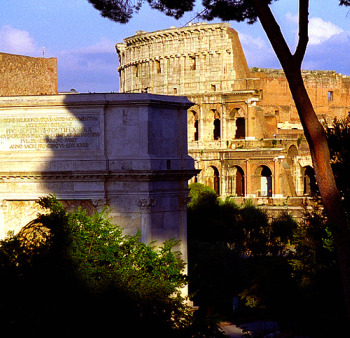 Even if you’ve never been drawn to exploring the nooks and crannies of off-the-beaten path Italy the way I am, chances are good that you’ve got Rome on your “must see someday” list. Italy’s capital offers an almost unbeatable mix of history, art, scenery, cuisine, and modern Italian life – so it’s not surprising that most Italy itineraries include a fair amount of time in Rome.
Even if you’ve never been drawn to exploring the nooks and crannies of off-the-beaten path Italy the way I am, chances are good that you’ve got Rome on your “must see someday” list. Italy’s capital offers an almost unbeatable mix of history, art, scenery, cuisine, and modern Italian life – so it’s not surprising that most Italy itineraries include a fair amount of time in Rome.
What makes the city a must-see, however, is exactly what can make it challenging from a tourist’s standpoint. It’s a huge city – especially if you’ve been making your way through Italy using my aforementioned 2-week itinerary and are comparing it to previous stops – and there’s just so much to see that it can feel overwhelming. So although you might initially think that five days in Rome is way too much time and you’ll get bored by the third day, let me assure you that it’s not and you won’t. (And if you prove me wrong and do end up bored? There are excellent day trips from Rome that will fill your time nicely.)
The bottom line is that whether you follow my suggestions below to the letter or you take half of them and create your own itinerary for the other half, you won’t run out of options in Rome. In fact, chances are good you’ll need to plan a return trip to catch all the stuff you missed the first time. And I think there are far worse problems to have, don’t you?
Here are my thoughts on what to do with five days in Rome.
Five Days in Rome
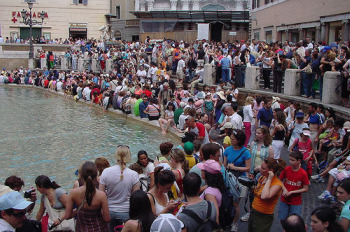 Rome, as mentioned, is big. Not only that, Rome is also crowded. And although it gets even busier during the summer high season when the bulk of the tourists come into town, there’s no real “low” season in Rome – there are tourists visiting the Italian capital all year long. Prices tend to drop and queues aren’t as long in the winter, late fall, and early spring, but even then you aren’t likely to have the Vatican Museum to yourself.
Rome, as mentioned, is big. Not only that, Rome is also crowded. And although it gets even busier during the summer high season when the bulk of the tourists come into town, there’s no real “low” season in Rome – there are tourists visiting the Italian capital all year long. Prices tend to drop and queues aren’t as long in the winter, late fall, and early spring, but even then you aren’t likely to have the Vatican Museum to yourself.
No matter when you plan to visit, Rome is an endless list of world-class art, famous churches, ancient monuments, and excellent places to eat. You could have a great time in the city almost by accident, turning a corner and all of a sudden being face to face with the Trevi Fountain or something, but if you are (a) a planner, or (b) just have a list of things you’d be really upset if you missed in Rome, this city takes a bit of preparation.
>> You might find my Rome survival tips useful, especially if you’re visiting for the first time.
One thing to take into consideration when you’re planning your own trip – whether you’re using my suggestions below or not – is that every museum and art gallery in Italy has certain days on which it’s closed. Sometimes this is only a few days a year on holidays, sometimes it’s the same day every week. Once you know which days you’ll be in Rome, you’ll need to look up which days the museums in Rome are closed so you can better plan your visit. If you don’t do this, you could get to your last day in the city – the day you had planned to visit two of your “must-see” sights – and find out only then that they’re closed. It’s easy to avoid that disappointment if you look up their closed days beforehand, and shuffle your schedule accordingly.
Day One in Rome
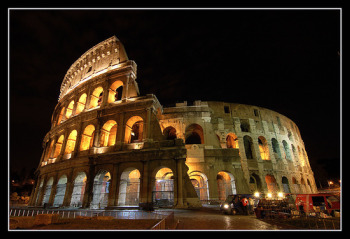 You’ll arrive in Rome on your first day on a train from Florence (assuming you’re following my itinerary), so you’ll only have a partial day to work with. For that reason, I’d recommend making your first day in Rome something of a “getting to know you” day. Don’t pack your first day with too many real “to-do” items if you can help it. That doesn’t mean you can’t visit a church or two, or take a spin through the Forum, if that’s how you want to spend your afternoon, of course – after settling into your hotel and noshing on something (can’t tackle this city on an empty stomach, after all).
You’ll arrive in Rome on your first day on a train from Florence (assuming you’re following my itinerary), so you’ll only have a partial day to work with. For that reason, I’d recommend making your first day in Rome something of a “getting to know you” day. Don’t pack your first day with too many real “to-do” items if you can help it. That doesn’t mean you can’t visit a church or two, or take a spin through the Forum, if that’s how you want to spend your afternoon, of course – after settling into your hotel and noshing on something (can’t tackle this city on an empty stomach, after all).
Before you get too swept away by monuments and art, however, I’d suggest doing a couple of things when you first get to Rome that will serve you well for the rest of your stay: buy a bus map, and find the Colosseum.
As long as you don’t get to Rome on a day when the local newsstands are closed already, make your way to the nearest newsstand – called an “edicola” (eh|DEE|koh|lah) in Italian – and buy a transportation map of the city and a few transit tickets. These Rome maps are pretty good city maps, but they’re invaluable bus maps. While the Rome Metro is easy enough to figure out (there are only two lines), the bus network is a complicated spiderweb. With a map, on the other hand, it’s your key to easy access to this sprawling city.
>> Read more about how to get around in Rome
If you’re lucky enough to be staying within walking distance of Rome’s most iconic monument, then this next “first day to-do” isn’t so much about getting your bearings as it is about rewarding yourself with a view of one of the most famous images of the entire country. Make your way to the Colosseum on your first afternoon in Rome, even if you’re not planning to take a tour that day, and come to terms with seeing in person something you’ve heard and read about your whole life – something that’s been greeting visitors just like you for two thousand years.
Pretty cool stuff, huh?
Now, if the line is short and you just can’t stand waiting, then go ahead and buy an entry ticket so you can get inside the Colosseum. But don’t feel like you have to do that right away if you’d rather not delve into any one monument just yet. In fact, after the Colosseum, I think this is a perfect opportunity to bask in the glow of a few more notable ancient monuments without buying a single entry ticket.
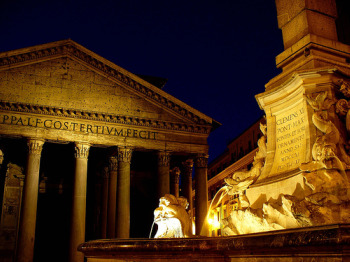 From the Colosseum, walk by the Roman Forum and look down over the ruins. Walk to the exquisite Pantheon – and this time actually go through the front doors. The Pantheon is free to enter, and it will give you some perspective later on for what Roman buildings look like when they’re more than just rubble.
From the Colosseum, walk by the Roman Forum and look down over the ruins. Walk to the exquisite Pantheon – and this time actually go through the front doors. The Pantheon is free to enter, and it will give you some perspective later on for what Roman buildings look like when they’re more than just rubble.
Still charmed by Rome? Still hungry for more of those “bucket list” experiences? Get a scoop of gelato and stroll toward the Spanish Steps for a look at the city’s best-known staircase and for some top-notch people-watching. Then, with the change from your gelato, wind your way to the Trevi Fountain and wait your turn to do the ritualistic coin-throwing routine.
The great thing about things like the Spanish Steps and the Trevi are that although the scenes there are always changing, they’re always the same (if y’know what I mean). Having seen these two things on your first day in Rome, you probably won’t have to stop by and see them again, in other words. And even though I love the Pantheon more than any other building in Rome, I’d even say that if you spent a little bit of time wandering around the inside and noticed the tombs of the painter Raphael, two Italian kings, and on Italian queen – then you may not even need to re-visit the Pantheon, either.
Cap the end of your first day in Rome with a meal on one of the city’s famous squares (though keep in mind you’re often paying for the view more than the food) or on a quiet side-street in a place recommended by the guy at the newsstand where you bought your bus map – just be sure you know what Roman specialties are in season so you know what to order.
Day Two in Rome
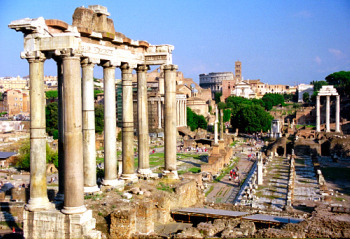 This is the day you’ll buy a ticket and finally go inside those historic monuments you glanced at yesterday. It’s a lot of history in one day, but since these monuments are very close to one another it’s more taxing on your brain than it is on your feet. Still, this is a day to wear your most comfortable walking shoes and dress comfortably (including wearing sunscreen if it’s sunny).
This is the day you’ll buy a ticket and finally go inside those historic monuments you glanced at yesterday. It’s a lot of history in one day, but since these monuments are very close to one another it’s more taxing on your brain than it is on your feet. Still, this is a day to wear your most comfortable walking shoes and dress comfortably (including wearing sunscreen if it’s sunny).
Personally, I like starting at the Colosseum because it is the monument in Rome. But it’s also the one with the longest lines at the ticket windows. You can avoid the long lines by buying a ticket at a different monument that also includes the Colosseum, which is ideal if you’re planning to visit all the big monuments. You can also buy a ticket online in advance. (Find out more about those options – and others – in my Colosseum travel guide.)
In the end, it doesn’t matter which monument you start with or what order you do them in – what matters is that you can do the Colosseum, the Forum, and Palatine Hill in that first full day in Rome. And if you skipped a trip around the inside of the Pantheon yesterday, be sure to include that in your first full day, too. Take snack breaks – gelato or something more substantial – between each stop on your tour of historic Rome, and if it’s summer be sure to keep your water bottle filled from the delightfully cool drinking fountains in Rome.
Other things you might want to include on your first day in Rome are the Piazza Navona (there are a couple churches right on the piazza, and in the summer it sometimes has a musician or other performer you can watch for awhile) and the monument to Vittorio Emanuele II, also known as “the typewriter.” The latter is a particularly great idea to help you get a better idea of the expanse of Rome, because you can take an elevator to the top for city-wide views.
Day Three in Rome
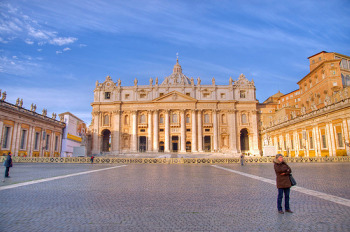 Vatican City merits most of one day, especially if you’re doing a guided tour of the Vatican Museums and St. Peter’s Basilica in one go. I do recommend getting a spot on a guided tour of Vatican City, partly because the museums are so vast it’s impossible to know what’s important to look at and what’s not (unless you’re a history buff or an art major) and partly because knowing the context of what you’re looking at makes it infinitely more meaningful.
Vatican City merits most of one day, especially if you’re doing a guided tour of the Vatican Museums and St. Peter’s Basilica in one go. I do recommend getting a spot on a guided tour of Vatican City, partly because the museums are so vast it’s impossible to know what’s important to look at and what’s not (unless you’re a history buff or an art major) and partly because knowing the context of what you’re looking at makes it infinitely more meaningful.
A guided tour typically starts by 9 or 10 in the morning and can last 4-6 hours, usually with a break for lunch between a swing through the museum and a tour of the Basilica, and most guides arrange it so you’ll meet them in Vatican City. Be aware that St. Peter’s has a strict dress code (many churches in Italy do, but few enforce it to the degree that St. Peter’s does) – no exposed shoulders, knees, or midriffs are allowed. I’ve seen people walking through this most dignified cathedral wearing disposible paper clothing over their shorts and tank-tops after being forced to buy the paper coveralls from a nearby vendor at a ridiculous price. Don’t get caught in this situation.
After your tour of the Vatican, you’ll still have daylight left and could visit a couple other things – like the nearby Castel Sant’Angelo (now a museum) and its bridge (lined with angel sculptures), or the Campo dei Fiori (a popular food market by day and lively square by night) just across the river. You could even walk along the Tiber to the Trastevere neighborhood and spend the rest of the afternoon and evening there if you wanted to. It’s well-known for having cheap eats and great nightlife, so it could be the ideal way to end your day.
Day Four in Rome
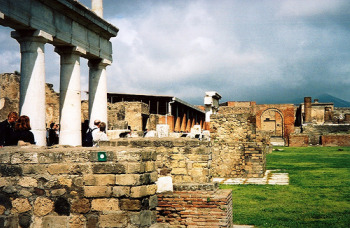 Even with all the amazing sights in Rome, it’s not a terrible idea to get out of the city for a day-trip – whether you’re like me and you need a break from Rome, you just want a change of scenery, or you’ve got one more must-do sight to conquer before you fly home. There are many great options for day trips from Rome, but the one I’m going to focus on here is a day trip to Pompeii.
Even with all the amazing sights in Rome, it’s not a terrible idea to get out of the city for a day-trip – whether you’re like me and you need a break from Rome, you just want a change of scenery, or you’ve got one more must-do sight to conquer before you fly home. There are many great options for day trips from Rome, but the one I’m going to focus on here is a day trip to Pompeii.
Now, Pompeii is more easily visited from a home-base in Naples or even Sorrento, but it’s do-able as a day-trip from Rome – and since Pompeii is one of Italy’s most famous attractions, you’re bound to go home feeling quite smug that you squeezed it into your trip.
As Melanie of Italofile notes in this helpful article, it’s possible to do a DIY tour of Pompeii from Rome – taking the train to Naples, then to Pompeii, buying an entry ticket and renting the audio guide, and then taking the trains back to Rome in the evening. But she also says that the cost difference between going the DIY route and booking a guided trip with a company based in Rome is small enough that if you can spare the extra money you might be better off going with a guided tour. Context Travel, based in Rome, offers a Pompeii Excursion from Rome.
If Pompeii isn’t on your must-see list for this trip but you still want a mini-escape from Rome, other great options for day-trips include Orvieto, Tivoli, Ostia Antica, Ostia Lido, and Sperlonga. Read more about day trips from Rome to see which one strikes your fancy.
Day Five in Rome
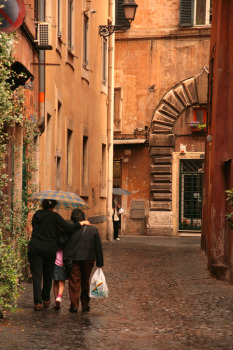 On your last day in Rome, you’ll be on clean-up duty – checking off all those things you’ll be truly disappointed if you miss on this trip. Maybe that’s a hunt for all the Caravaggio paintings in churches around Rome. Maybe it’s a day spent shopping along the Via dei Condotti. Maybe it’s an “Angels & Demons” tour of Rome. Maybe you’d like to tour the museums on the Capitoline Hill instead of just looking over the Forum from their balcony. Maybe a scavenger hunt through Rome is the perfect way to end your trip. Maybe you’d like to take another stroll through the Trastevere neighborhood (or a first one, if you didn’t go after your Vatican tour) for a glimpse of small-town Rome.
On your last day in Rome, you’ll be on clean-up duty – checking off all those things you’ll be truly disappointed if you miss on this trip. Maybe that’s a hunt for all the Caravaggio paintings in churches around Rome. Maybe it’s a day spent shopping along the Via dei Condotti. Maybe it’s an “Angels & Demons” tour of Rome. Maybe you’d like to tour the museums on the Capitoline Hill instead of just looking over the Forum from their balcony. Maybe a scavenger hunt through Rome is the perfect way to end your trip. Maybe you’d like to take another stroll through the Trastevere neighborhood (or a first one, if you didn’t go after your Vatican tour) for a glimpse of small-town Rome.
Or maybe you’d like to indulge in something a little more strange.
Rome has plenty of things to satisfy the history nut and the art enthusiast, but the city has a few truly odd sights as well. And if you’re looking for an easy way to differentiate your vacation photos and stories from everyone else’s, a trip to one of the weird attractions in Rome is a great way to do that. The Cappuchin Crypt is perhaps the most famous of Rome’s strange sights, but there are many more where that one came from. Read more about the weird things to do in Rome and see if any of them strikes your fancy.
And if all of that seems just a little too weird, there are still countless more art galleries, museums, and art-laden churches you could fill your final day with. You’ll also spend some of your evening trying to cram all the souvenirs you’ve bought into your suitcase for the trip home, so be sure to attempt this feat early enough so that you can reward your success with a nice bottle of wine with dinner.
For your flight out, you’ll need this information on how to get to Rome’s Fiumicino Airport from Rome. And don’t despair – Rome will be here whenever you decide to return.
You did remember to throw your coin in the Trevi, right?
More Useful Information for Visiting Rome
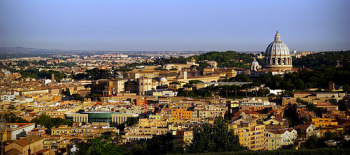 There’s more than 5 days’ worth of things to do and see in Rome, but no matter how much time you spend in the city these articles will likely come in handy for you:
There’s more than 5 days’ worth of things to do and see in Rome, but no matter how much time you spend in the city these articles will likely come in handy for you:
- Rome Travel Guide
- Top 10 Things to Do in Rome
- Things You Should Know About Rome
- What to Do in Rome
- Free Things to Do in Rome
- Rome Transportation Guide
- Hostels in Rome
- Cheap Hotels Near the Colosseum
- Weird Attractions in Rome
- Day Trips from Rome
- Shops at Fiumicino Airport
photos, top to bottom, by: David Paul Ohmer, grenade, Rosino, yeowatzup, David Paul Ohmer, Ed Yourdon, carolynconner, Andrew, House of Sims